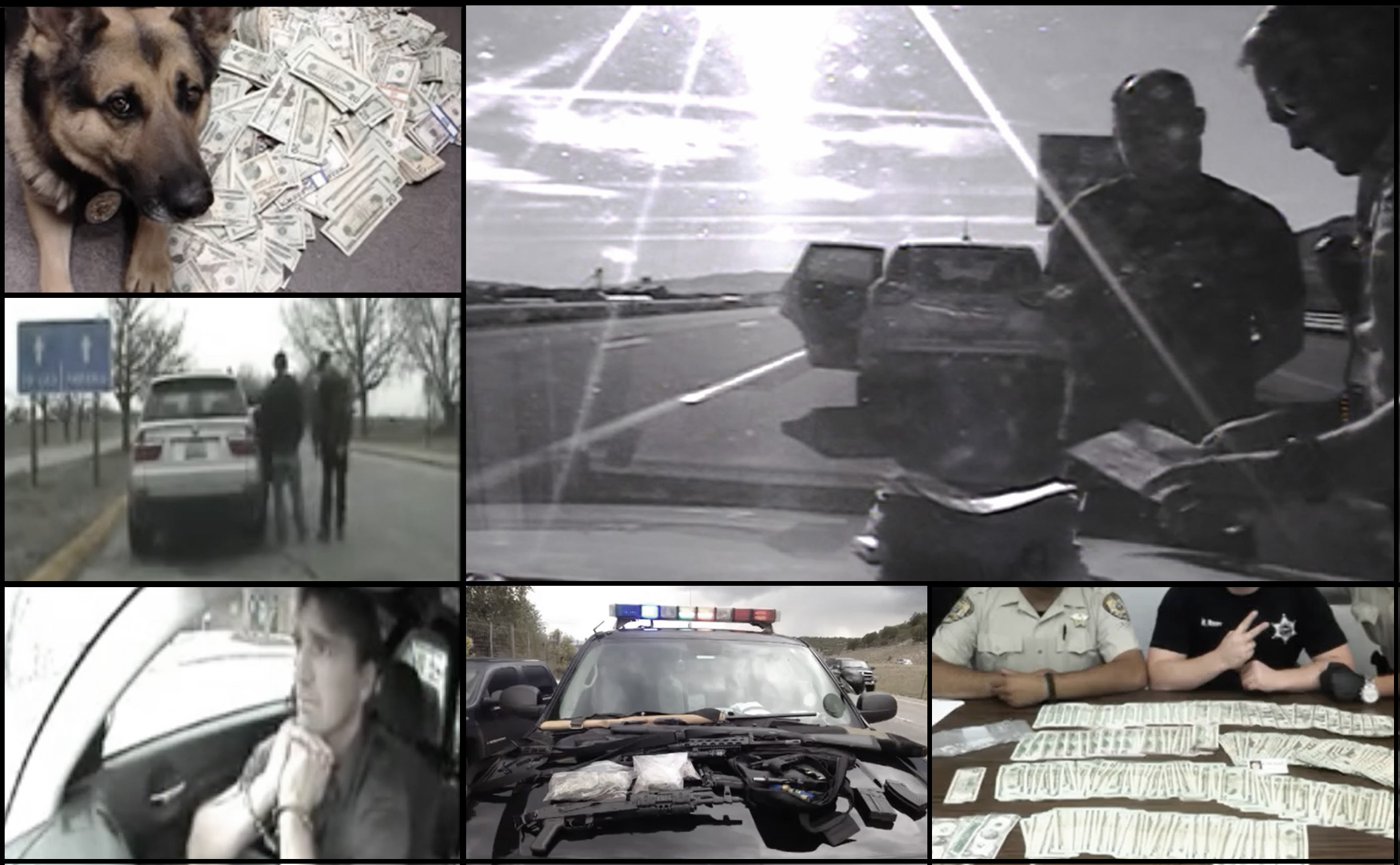
Police agencies have used hundreds of millions of dollars taken from Americans under federal civil forfeiture law in recent years to buy guns, armored cars and electronic surveillance gear. They have also spent money on luxury vehicles, travel and a clown named Sparkles.
The details are contained in thousands of annual reports submitted by local and state agencies to the Justice Department’s Equitable Sharing Program, an initiative that allows local and state police to keep up to 80 percent of the assets they seize. The Washington Post obtained 43,000 of the reports dating from 2008 through a Freedom of Information Act request.
The documents offer a sweeping look at how police departments and drug task forces across the country are benefiting from laws that allow them to take cash and property without proving a crime has occurred. The law was meant to decimate drug organizations, but The Post found that it has been used as a routine source of funding for law enforcement at every level.
“In tight budget periods, and even in times of budget surpluses, using asset forfeiture dollars to purchase equipment and training to stay current with the ever-changing trends in crime fighting helps serve and protect the citizens,” said Prince George’s County, Md., police spokeswoman Julie Parker.
Brad Cates, a former director of asset forfeiture programs at the Justice Department, said the spending identified by The Post suggests police are using Equitable Sharing as “a free floating slush fund.” Cates, who oversaw the program while at Justice from 1985 to 1989, said it has enabled police to sidestep the traditional budget process, in which elected leaders create law enforcement spending priorities.
“All of this is fundamentally at odds with the U.S. Constitution,” said Cates, who recently co-wrote an article calling for the program’s abolition on The Post’s editorial page. “All of this is at odds with the rights that Americans have.”
Of the nearly $2.5 billion in spending reported in the forms, 81 percent came from cash and property seizures in which no indictment was filed, according to an analysis by The Post. Owners must prove that their money or property was acquired legally in order to get it back.
The police purchases comprise a rich mix of the practical and the high-tech, including an array of gear that has helped some departments militarize their operations: Humvees, automatic weapons, gas grenades, night-vision scopes and sniper gear. Many departments acquired electronic surveillance equipment, including automated license-plate readers and systems that track cellphones.
The spending also included a $5 million helicopter for Los Angeles police; a mobile command bus worth more than $1 million in Prince George’s County; an armored personnel carrier costing $227,000 in Douglasville, Ga., population 32,000; $5,300 worth of “challenge coin” medallions in Brunswick County, N.C.; $4,600 for a Sheriff’s Award Banquet by the Doña Ana County (N.M.) Sheriff’s Department; and a $637 coffee maker for the Randall County Sheriff’s Department in Amarillo, Tex.
Sparkles the Clown was hired for $225 by Chief Jeff Buck in Reminderville, Ohio, to improve community relations. But Buck said the seizure money has been crucial to sustaining long-term investigations that have put thousands of drug traffickers in prison.
“The money I spent on Sparkles the Clown is a very, very minute portion of the forfeited money that I spend in fighting the war on drugs,” he told The Post.
About 5,400 departments and drug task forces have participated in the Equitable Sharing Program since 2008. Justice spokesman Peter Carr said the program is an effective weapon to fight crime but should not be considered “an alternative funding source for state and local law enforcement.”
“It removes the tools of crime from criminal organizations, deprives wrongdoers of the proceeds of their crimes, recovers property that may be used to compensate victims, and deters crime,” he said in a statement. “Any funds received through the equitable sharing program are meant to enhance and supplement, not supplant or replace an agency’s appropriated budget and resources.”
Money for Gear, Training
A local or state police agency can seize cash or property under federal law through the Equitable Sharing Program when a federal agency such as the Drug Enforcement Administration or Immigration and Customs Enforcement agrees to adopt the seizure under federal law. Federal agencies generally are allowed to keep 20 percent or more of the seizure after an adoption.
In September, The Post reported that police across the country became more aggressive in their use of federal civil asset forfeiture laws after the Sept. 11, 2001, terrorist attacks. Officials at Justice and the Department of Homeland Security encouraged a technique known as highway interdiction to help in the fight against drugs and terror.
There have been 61,998 cash seizures on highways and elsewhere since 9/11 without search warrants or indictments and processed through the Equitable Sharing Program, according to an analysis of Justice data obtained by The Post.
Equitable Sharing participants must follow rules contained in a 50-page Equitable Sharing guide that require the proceeds of seizures to be used “by law enforcement agencies for law enforcement purposes only.”
Permissible uses include overtime pay, training, building construction and improvements and equipment — everything from file cabinets and fitness gear to automatic weapons, surveillance systems and cars. They also can use proceeds to buy food and drinks at conferences or during disaster operations.
Police generally may not pay ongoing salaries or otherwise support annual budgets. One exception allows for departments to pay salaries of newly hired officers for one year or officers assigned to a drug task force as a replacement “so long as the replacement officer does not engage in the seizure of assets or narcotics law enforcement as a principal duty.”
The Justice Department has about 15 employees assigned to overseeing compliance. Five employees review thousands of annual reports for discrepancies. Justice employees also use analytical tools to search for spending patterns. Several attorneys review all sharing requests for $1 million or more, Carr said, adding that the locals also do their own audits.
The annual reports from local and state police are required to help “promote public confidence” in the program and to protect against “waste, fraud and abuse,” the guidelines say. But the forms provide few details about what is actually purchased, according to documents and interviews. That is in part because the department leaves it up to local officials to decide how to categorize their spending. There is little room to provide line-item detail.
Justice’s inspector general’s office has conducted 25 audits on spending since 2008, an average of four a year, examining more than $18 million in Equitable Sharing spending, roughly three-quarters of 1 percent of the money spent during that time. Justice has challenged millions of dollars in spending as unsupported or unallowable.
One audit examined about $3.4 million in Equitable Sharing funds that the Oklahoma Highway Patrol spent from July 2009 to June 2012.
The audit found $1.9 million in unallowable and unsupported expenditures relating to salaries, overtime pay, construction, fees paid to contractors and the use of two Ford F-150 pickup trucks by non-law enforcement personnel.
Oklahoma authorities did not return calls seeking comment.
Auditors found the Mesa County, Colo., Sheriff’s Office paid thousands for projectors, scanner equipment and other items that were not intended for law enforcement. They also paid for 20 lawyers in the Mesa County prosecutor’s office to attend a conference at the Keystone ski resort. Auditors questioned more than $78,000 in spending.
The Mesa Sheriff’s Office also did not respond to calls from The Post.
Trading Cards and BMWs
One task force used the money for a subscription to High Times, a magazine for marijuana enthusiasts, at $29.99 for a year.
Several departments bought custom-made trading cards, complete with photos and data about their officers. Some, including police in Chelsea, Mass., share them with children in their communities.
“We have found that this is a great way to build trust and foster long-lasting relationships with the youth in our community who get to know officers on a first-name basis,” said Chelsea Police Chief Brian Kyes.
Ten agencies have used the asset forfeiture funds to pay their fees for the Defense Department’s excess property initiative, better known as the 1033 program, which enables local and state police to buy surplus military-grade equipment at cut rates. The equipment includes automatic weapons, night-vision gear and clothing.
Police in Sahuarita, Ariz., paid $4,300 to outfit a Humvee obtained through the 1033 program. The New Bedford, Mass., Police Department in 2012 paid $2,119 for shipping costs for M-16s from the military.
Dozens of sheriff and police offices paid a total of more than $100,000 for keepsakes known as “challenge coins” and lapel pins that they could share with one another and with local residents.
Scores of departments spent money on vehicles. Many of them were typical police cruisers, but dozens were new and used sports and luxury cars, including at least 15 Mercedes, a dozen Mustangs, a handful of BMWs and two Corvettes.
Others bought a variety of armored cars. Among them was the police department in Douglasville, Ga., and the sheriff’s office in Douglas County, Ga., which teamed up several years ago to buy an eight-ton, $227,000 BearCat (Ballistic Engineered Armored Response Counter Attack Truck).
Douglasville Deputy Chief Gary E. Sparks said they have used the vehicle a few times in barricade situations. But mostly it has been deployed for “officer down” and SWAT team exercises.
“It’s better to have it and not need it than need it and not have it,” he said.
Police in Ferguson, Mo., also participate in Equitable Sharing. Since 2008, the department reported using seizure proceeds to buy $18,000 in weapons and protective gear, $71,000 in computers and communications gear, and about $43,000 in electronic surveillance equipment. Some of the money was seized in partnerships with other agencies, the annual reports show.
Jurisdictions in the Washington region have used the federal asset forfeiture program as well.
Virginia State Police spent $33 million on buildings and improvements and $11 million on computers and communications gear. A state police spokeswoman said the funds came from money forfeited by Purdue Frederick Company, the maker of OxyContin, to settle allegations that the company played down the drug’s addictive properties.
The D.C. Metropolitan Police Department was a leader in spending on informants and undercover drug purchases, reporting about $3.3 million under that category. The department declined a request to provide details.
Prince George’s police spent $382,000 on license-plate readers, $56,000 to paint two aging helicopters and an undisclosed amount on a “cell site simulator” that can surreptitiously track cellphones.
Parker, the Prince George’s police spokeswoman, said the cellphone-tracking system is only used under court order and that the department “follows best practice policies” when spending forfeiture funds.
Fairfax County police have spent $1.3 million on weapons and protective gear, $561,000 on buildings and improvements and $208,000 on electronic surveillance gear. The department declined to share details about the spending.
The Justice Department audited Fairfax’s spending in 2009 and 2010 and found the department had complied with the guidelines at that time.
“Our financial stewardship of our Seized Account Funds is in compliance with all Federal rules and laws, State rules and laws, County rules and laws, and we undergo audits of these accounts by local and federal agencies,” Col. Edwin C. Roessler Jr., the Fairfax police chief, said in a statement.
“Additionally, we are subjected to internal audit processes to review all requests for expenditures to ensure purchases are pre-approved for compliance.”
Steady Money for Georgia Town
The Post analysis found that since 2008, more than 500 departments and drug task forces have reported receiving the equivalent of 20 percent of their annual spending plans at least once. Nearly 100 have done so in at least three of the past six years.
The local department that makes the most consistent use of Equitable Sharing funds per capita is in Braselton, Ga., a town of about 8,000 people along Interstate 85 northeast of Atlanta. It has reported receiving the equivalent of 20 percent or more of its budget from the Justice program in five of the past six years, documents show.
The Braselton Police Department’s approach to Equitable Sharing offers insights about the latitude the Justice Department gives local and state departments to spend seized proceeds. It also underscores how little Equitable Sharing participants are required to disclose to Justice each year.
According to the town’s annual reports, police in Braselton have spent $79,000 on weapons and protective gear since 2008, $139,000 on travel and training, $134,000 on salaries, $224,000 on computers and communications gear, $875,000 on a category characterized on the Justice form as “other,” and $905,000 on buildings and improvements.
Their spending included $806,000 for the purchase and modification of vehicles.
In interviews, Assistant Chief Lou Solis said that not all the reported spending went to items for the town police. He said that Braselton uses its membership in the Equitable Sharing Program to buy things for law enforcement partners, such as the Georgia State Patrol.
The federal guidelines allow the formation of task forces and the participants to decide how to split the seizures among themselves, with Justice’s approval. Most of Braselton’s seizure proceeds came as a result of its participation in an Atlanta-based DEA drug task force that relies heavily on local police. Braselton has one officer assigned to the task force, Solis said.
Braselton police recently paid $6,000 for copiers for a nearby DEA office. “The DEA says, ‘Hey man, we need a copier,’ ” Solis said.
In some instances, town police help out on “whisper stops” after receiving informal tips about smugglers from the DEA, he said. Some of the seizures are made by the state patrol on nearby I-85, with help from Braselton officers, he said.
State police have sometimes partnered with Braselton on seizures in exchange for pledges from town police to provide cars and equipment for the state police.
For example, Solis said, Braselton police recently bought 27 M-4 assault rifles, at about $2,000 each, for state police with proceeds from Equitable Sharing. Braselton also paid almost $8,000 in program funds for radar, lights and a tag reader for the state police.
The deals with Braselton enabled state police offices to receive the direct benefit of seizure proceeds rather than have the money go through the state patrol’s general fund, according to Solis and Capt. Kermit Stokes, a state patrol official.
Braselton police also used seizure proceeds to build an enclosed shooting range used by local, state and federal authorities, including the Department of Homeland Security, which also contributed funding, Solis said.
“It’s legit. We’re not buying stuff just to buy stuff,” he said, adding, “We spend the money if we have it. . . . It’s pretty cool. We’re not only able to help us, we’re able to help others.”
In every instance, planned purchases are submitted to town authorities before being approved by Braselton’s police chief, he said. Every request from Georgia’s state patrol is accompanied by a formal letter, as required by the Justice program, he said.
“It’s checked and it’s double-checked,” Solis said about the spending. “It’s audited.”
When town police help out, other agencies sometimes promised to include them in a “DAG-71,” the federal form that specifies how sharing should occur. So many seizures have occurred in recent years, leading to so much sharing among local, state and federal authorities, that it has become common for one officer to tell another, “We’re going to ‘DAG you in,” Solis said.
After The Post brought the transactions to Justice’s attention, a department official told Braselton to stop using Equitable Sharing funds to buy items for other departments, said Carr, the Justice spokesman.
Such transactions were not “explicitly prohibited previously,” but a new interim guidance for the program was issued this summer, Carr said.
“Braselton Police Department is now aware that this is not permitted and has assured the department it will comply with the new guidance,” Carr said. He added that other departments had made similar transactions in recent years.
Braselton Police Chief Terry Esco said he was not aware of the interim guidance but is happy to comply.
“We just never received the e-mail,” he said.
3 WAYS TO SHOW YOUR SUPPORT
- Log in to post comments














